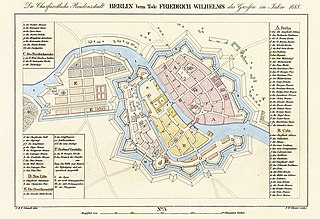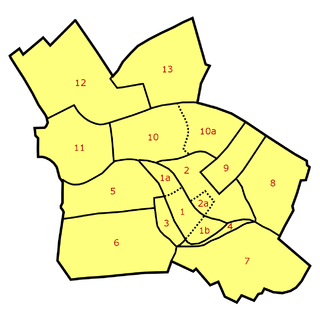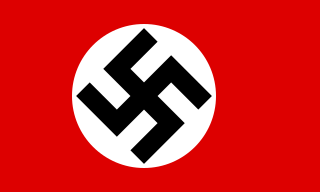 W
WThe history of Berlin starts with its foundation in the 13th century. It became the capital of the Margraviate of Brandenburg in 1417, and later of Brandenburg-Prussia, and the Kingdom of Prussia. Prussia grew rapidly in the 18th and 19th century, and formed the basis of the German Empire in 1871, which survived until 1918, after the empire's defeat in World War I.
 W
WAlt-Berlin, also spelled Altberlin, is a neighborhood (Stadtviertel), situated in the Berliner locality (Ortsteil) of Mitte, part of the homonymous borough. In the 13th century it was the sister town of the old Cölln, located on the northern Spree Island in the Margraviate of Brandenburg. It counts in its territory the zone of Nikolaiviertel.
 W
WThe Anhalter Bahnhof is a former railway terminus in Berlin, Germany, approximately 600 m (2,000 ft) southeast of Potsdamer Platz. Once one of Berlin's most important railway stations, it was severely damaged in World War II, and finally closed for traffic in 1952, when the GDR-owned Deutsche Reichsbahn rerouted all railway traffic between Berlin and places in the GDR avoiding the West Berlin area. The station's name lives on in the Berlin S-Bahn station of the same name, opened in October 1939 as part of the North-South S-Bahn link.
 W
WThe Berlin Fortress was the fortification of the historic city of Berlin. Construction started in 1650. The demolition of its ramparts began in 1740.
 W
WBerolina is the New Latin female personification of Berlin and the allegorical female figure symbolizing the city. One of the best-known portraits of Berolina is the statue that once stood in Alexanderplatz.
 W
WCafé Achteck is a common local slang for certain public urinals in Berlin. These urinals consist of seven ornamentally decorated, green-painted cast iron wall segments, arranged onto an octagonal floor plan, provide standing room for seven men, and the eighth side is the entrance. The roof is crowned by an eight-sided ventilation hood. In front of the entrance, there is a privacy screen of at least three segments. The design for these urinals came from the city councillor Carl Theodor Rospatt in 1878. In 1920 there were about 142 of these urinals in Greater Berlin, and today about a dozen preserved specimens can be found.
 W
WThe coat of arms of Berlin is used by the German city state as well as the city itself. Introduced in 1954 for West Berlin, it shows a black bear on a white shield. On top of the shield is a special crown, created by the amalgamation of the mural crown of a city with the so-called people's crown (Volkskrone), used in Germany to denote a republic. Berlin's various boroughs use their own emblems.
 W
WCölln was the twin city of Old Berlin (Altberlin) from the 13th century to the 18th century. Cölln was located on the Fisher Island section of Spree Island, opposite Altberlin on the western bank of the River Spree, until the cities were merged by Frederick I of Prussia to form Berlin in 1710. Today, the former site of Cölln is the historic core of the modern Mitte locality of the Berlin-Mitte borough in central Berlin.
 W
WIn December 2015, the city-state of Berlin had a population of 3,520,031 registered inhabitants in an area of 891.82 square kilometers (344.33 sq mi). The city's population density was 3,944 inhabitants per km². Berlin is Germany's largest city and the most populous city proper in the European Union.
 W
WDorotheenstadt (help·info) is a historic zone or neighbourhood (Stadtviertel) of central Berlin, Germany, which forms part of the locality (Ortsteil) of Mitte within the borough (Bezirk) also called Mitte. It contains several famous Berlin landmarks: the Brandenburg Gate, the Pariser Platz, and Unter den Linden.
 W
WThe Fall of Berlin took place on 27 October 1806 when the Prussian capital of Berlin was captured by French forces in the aftermath of the Battle of Jena–Auerstedt. The French Emperor Napoleon Bonaparte entered the city, from which he issued his Berlin Decree implementing his Continental System. Large-scale plundering of Berlin took place.
 W
WBerlin is a major center in the European and German film industry. It is home to more than 1000 film and television production companies and 270 movie theaters. Three hundred national and international co-productions are filmed in the region every year. The world renowned Babelsberg Studios and the production company UFA are located outside Berlin in Potsdam.
 W
WThe flag of Berlin has three stripes of red-white-red, the two outer stripes each occupying a fifth of its height, the middle the remaining three fifths. It is emblazoned with a bear on the civil flag, while it bears the coat of arms of Berlin on the state flag.
 W
WThe Gau Berlin was an administrative division of Nazi Germany from 1933 to 1945 in the German capital Berlin. Before that, from 1928 to 1933, it was the regional subdivision of the Nazi Party in that area. From 1926 to 1928 Berlin was part of the Gau Berlin-Brandenburg which was split into two separate Gaue on 1 October 1928.
 W
WThe German Chancellery is an agency serving the executive office of the Chancellor of Germany, the head of the federal government, currently Angela Merkel. It is the largest government headquarters in the world. The Chancellery's primary function is to assist the Chancellor in coordinating the activities of the federal government. The Head of the Chancellery holds the rank of either a Secretary of State (Staatssekretär) or a Federal Minister (Bundesminister), currently held by Helge Braun. The headquarters of the German Chancellery is at the Federal Chancellery building in Berlin.
 W
WThe Isted Lion, German: Flensburger Löwe or Idstedter Löwe) is a Danish war monument originally intended as a monument of the Danish victory over German-minded Schleswig-Holstein insurgents in the Battle of Isted (Idstedt) on 25 July 1850, during the First Schleswig War which was a civil war within the Danish Realm, although with troops from Prussia supporting the Schleswig-Holstein insurgents. At its time it was the largest battle in Scandinavian history.
 W
WJaxa of Köpenick was a prince of the West Slavic Sprevan Duchy of Kopanica. He was an opponent of Albert the Bear during the formation of Brandenburg in 1157.
 W
WThe Kindl-Bühne Wuhlheide is a cultural heritage site in Berlin which serves as an open-air performance venue in the shape of an amphitheater. It is part of Volkspark Wuhlheide in the Berlin-Oberschöneweide neighborhood in the district of Bezirk Treptow-Köpenick. The Kindl-Bühne has a non-seated spectator capacity of 17,000 and a seated capacity of 15,300. It is the second-largest open-air stage in Berlin, trailing only the Waldbühne in size.
 W
WThe Kroll Opera House in Berlin, Germany, was in the Tiergarten district on the western edge of the Königsplatz square, facing the Reichstag building. It was built in 1844 as an entertainment venue for the restaurant owner Joseph Kroll, and redeveloped as an opera house in 1851. It also served as the assembly hall of the Reichstag from 1933 to 1942. Severely damaged by the bombing of Berlin in World War II and the Battle of Berlin, it was demolished in 1951.
 W
WMokum (מקום) is the Yiddish word for "place" or "safe haven". It is similar to the Hebrew word makom, from which it is derived.
 W
WNazi architecture is the architecture promoted by Adolf Hitler and the Nazi regime from 1933 until its fall in 1945. It is characterized by three forms: a stripped neoclassicism, typified by the designs of Albert Speer; a vernacular style that drew inspiration from traditional rural architecture, especially alpine; and a utilitarian style followed for major infrastructure projects and industrial or military complexes. Nazi ideology took a pluralist attitude to architecture; however, Adolf Hitler himself believed that form follows function and wrote against "stupid imitations of the past".
 W
WFounded about 1200, the Nikolaiviertel (help·info) of Alt-Berlin, together with nearby Cölln, jointly make up the reconstructed historical heart of the German capital of Berlin. It is located in Mitte locality, five minutes away from Alexanderplatz.
 W
WThe Oberbaum Bridge is a double-deck bridge crossing Berlin's River Spree, considered one of the city's landmarks. It links Friedrichshain and Kreuzberg, former boroughs that were divided by the Berlin Wall, and has become an important symbol of Berlin’s unity.
 W
WThe Palais am Festungsgraben, originally known as the Palais Donner, is a stately building in Berlin’s Mitte subdistrict located behind, and facing, the ensemble of chestnut trees around the Neue Wache, near the eastern terminus of the boulevard Unter den Linden. The name refers to its construction next to a redundant canal, gradually filled in by 1883, which had originally been a moat surrounding the 17th century city wall. Built as a private residence, it later housed a succession of Prussian government offices, and after World War II various cultural institutions in the Soviet sector of Berlin. After administrative authority was transferred to the newly established German Democratic Republic (GDR) in 1949 it hosted a succession of institutions established to further German-Russian contacts. Since German reunification it has accommodated a theater and from 2004 an art gallery.
 W
WPlatz der Republik is a square in Berlin, Germany. It is located in the Tiergarten, directly in front (west) of the Reichstag building. The square has an area of about 36,900 square meters and is almost completely covered by grass but is decorated with some hedges and a few trees.
 W
WThe Reich Chancellery and Führerbunker Complex: An Illustrated History of the Seat of the Nazi Regime is a 2006 book by Steven Lehrer, in which Lehrer recounts the history of a group of Berlin buildings, from their construction in the 18th century until their complete destruction during and after World War II.
 W
WScheunenviertel (help·info) is a neighborhood of Mitte in the centre of Berlin. It is situated to the north of the medieval Altberlin area, east of the Rosenthaler Straße and Hackescher Markt.
 W
WThe Stennes Revolt was a revolt within the Nazi Party in 1930-1931 led by Walter Stennes (1895–1983), the Berlin commandant of the Sturmabteilung (SA), the Nazi's "brownshirt" storm troops. The revolt arose from internal tensions and conflicts within the Nazi Party of Germany, particularly between the party organization headquartered in Munich and Adolf Hitler on the one hand, and the SA and its leadership on the other hand. There is some evidence that Stennes may have been paid by the government of German chancellor Heinrich Brüning, with the intention of causing conflict within the Nazi movement.
 W
WThe Weißensee Cemetery is a Jewish cemetery located in the neighborhood of Weißensee in Berlin, Germany. It is the second largest Jewish cemetery in Europe. The cemetery covers approximately 42 ha and contains approximately 115,000 graves. It was dedicated in 1880.